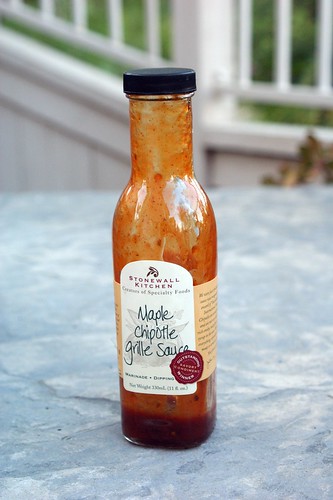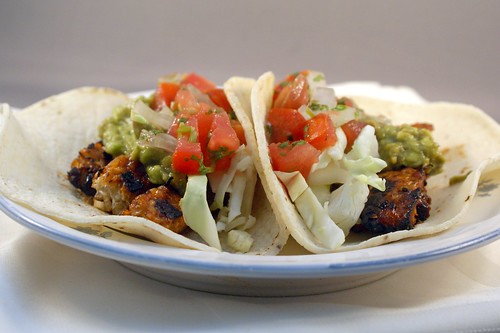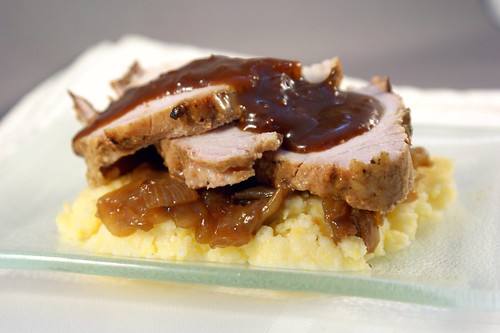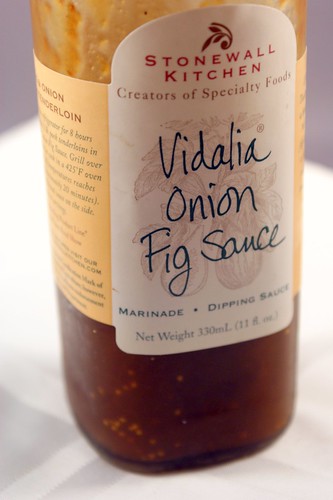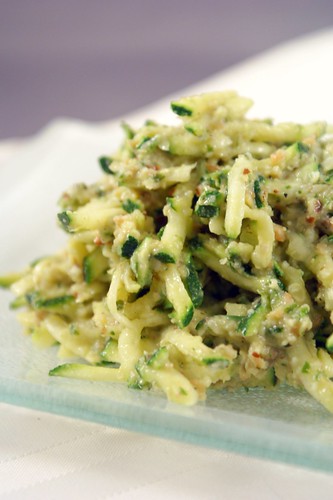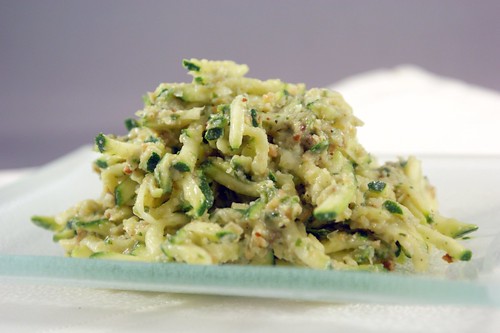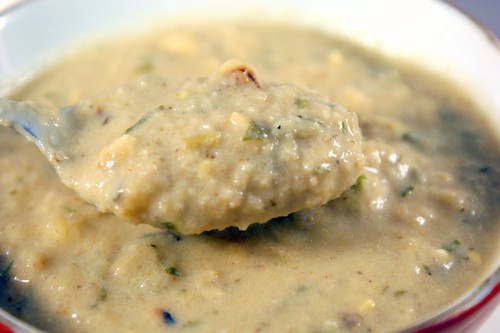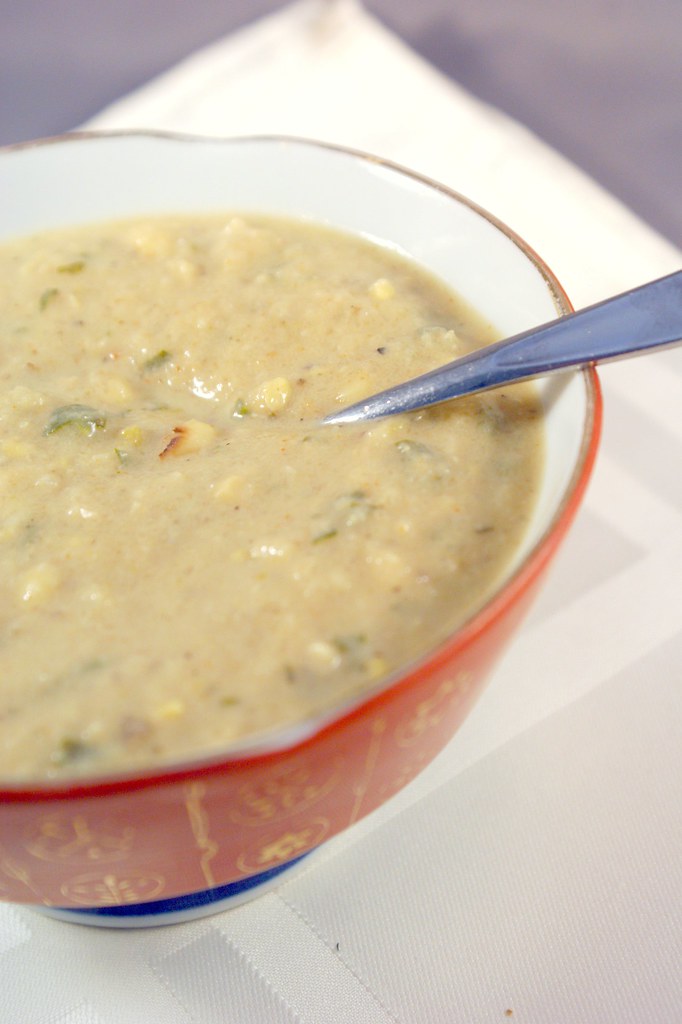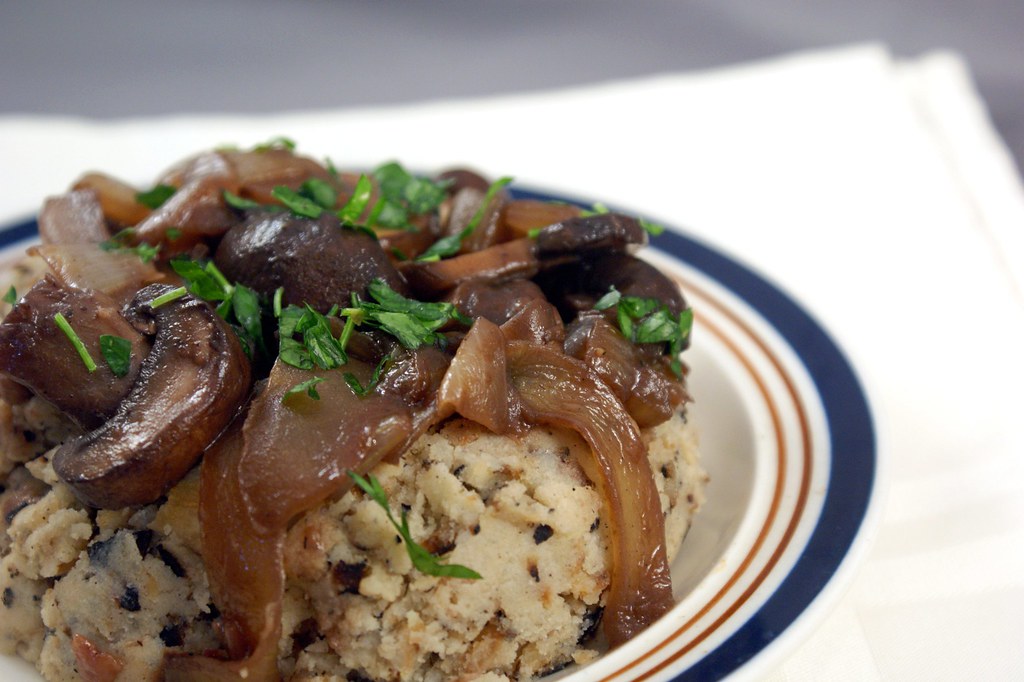That’s not the only bandwagon I jumped on recently. A few weeks ago Husband and I joined the scores of other bloggers who have made the same big, life-changing decision of late. That’s right...we joined a CSA*! Every other week we’ll be getting a big box of fresh from the local farm organic produce. The “get what you get” nature of a CSA gave me pause when we first considered joining a couple of years ago. Another way my confidence in my cooking has progressed – I don’t need a recipe to follow and an iron-clad shopping list to buy from every week. I’m now comfortable with pulling a head of romanesco cauliflower out of a box, knowing I’ve never cooked with it before. In the end produce is produce. Sure, certain flavors and preparations work better than others, but ultimately, if it’s fresh, it’s going to be delicious. And if I’m ever really stumped, I’ll channel my grandmother and throw it into a pot of broth and add things until it is some kind of delicious soup. I’m glad we waited to join. A few years ago, I might have met the bi-weekly pickup with stress and trepidation of how to consume everything in a delicious way before it expired. Now I wake up excited for “CSA pickup day”! It helps that my love of fresh produce has grown to obsessive proportions.
It’s a good thing Husband doesn’t mind being married to a woman whose idea of evening conversation is naming off the different possibilities for dishes using CSA ingredients…
I’m happy to report my first CSA box experience had very little stumpage. Quite the opposite, in fact. I pulled out a beautiful bushel of asparagus and did a little dance (I hope no one was watching…) because I knew exactly how I wanted to use it. Here’s how it went down:
- Husband had requested I make grilled pizza of some kind.
- The pizza dough recipe I wanted to try required overnight resting, so there were several balls of pizza dough ready and waiting in the fridge.
- I had bought some Iberico cheese on a whim at Trader Joe’s. I wanted to try something Spanish and it had a nice soft, yet sturdy feel to it.
- I had just read about a shaved asparagus salad that sounded divine.
Did I mention I made garlic-infused olive oil, then used the oil to brush the pizza dough before it went on the grill, and used the resulting garlic confit on top of the pizza, hidden beneath the creamy melted cheese? That happened.
I also put raw asparagus on a pizza that only cooked for about 2 minutes. Not quite raw, but definitely not cooked. It was sweet! Who knew raw asparagus had a mild sweetness to it? After I had shaved each asparagus spear down to a nub with my vegetable peeler, I bit off that last nubby bit before the woody stem. It was so crunchy and succulent, I knew the salad by itself, which I simply tossed with lemon juice and red pepper flakes, would be fantastic.
The farm fresh asparagus made an interesting and discernable difference. All asparagus spears get woody and tough at the bottom of the stem, but this asparagus was so tender that quite a few spears weren’t woody at all. I was able to use all but the tiniest of partial inches off the bottom. And I have been known to sacrifice almost half a stalk out of fear of the woody end.
I was equally pleased with how my pizza dough turned out. Some extra hydration and the overnight resting allowed the whole wheat flour to properly mellow along with it’s already mellow cousin, AP flour. When I went to start shaping it, it practically melted over my fists and stretched beautifully with just the slighted tug. More relaxed gluten I have never seen. I stretched it super thin, so the quick, high heat from the grill would give it a charred, crispy flatbread consistency. The earthy flavors from char and whole wheat went beautifully with the Iberico and Parmesan cheeses.
The Iberico cheese was a new ingredient to me, and I was so happy with it. It was sturdy enough to grate, yet creamy enough to pair nicely with the Parmesan. Sometimes creamy cheeses can be a little bland in pizza applications. Not this one. I wouldn’t say it’s pungent, but it definitely has a mild grassy earthiness that was a perfect complement to the vegetal asparagus. Milder than goat cheese, but stronger than mozzarella. I think I’m in love.
It sure sounds like a lot of steps – making dough, infusing oil, peeling individual asparagus spears, etc. But that’s the great thing about grilled pizza – it comes together really fast! The actual cook time is almost negligible. “Infusing” something sounds like a lot of work, but really you just throw some garlic cloves in some oil over low heat and mostly forget about it for a few minutes (like, say, while you’re prepping the asparagus). And of course, you can always buy pizza dough. Trader Joe’s even has a wheat option! Because if you’re like me, you balk at eating white breads, yet inexplicably have no qualms with using white flour in cakes, pies, muffins, and every other dessert application. Um, moderation?
This pizza has, after just one go, already carved a special place in my
Sorry for the pictures, featuring what can only be described as limp pizza. In my rush to get the leftover pizza put away and out of the reach of a certain cohabitating pizza-monster, I may have stacked and smushed the slices into a Tupperware container, forever ruining their structural integrity. Don’t be like me. Just wrap it in foil.
*Did I get ya!? Have you noticed all the bloggers are pregnant right now? Not gonna lie, it’s weirding me out.
Grilled Shaved Asparagus Pizza
adapted from Smitten Kitchen
Makes one 10-12” pizza
1 portion of pizza dough (see recipe below – Note: it’s an overnight process!)
¼ cup olive oil
6 cloves garlic
1 bunch asparagus (~1 lb.)
Juice of ½ lemon (~ 1 TB)
¼ tsp salt
¼ tsp freshly ground black pepper
¼ tsp red pepper flakes
½ cup freshly grated parmesan cheese
½ cup freshly grated Iberico cheese (any soft cheese like mozzarella, goat, or feta will do)
- Preheat your grill to medium heat.
- In a small saucepan over the lowest heat you can manage on your stove, combine the olive oil and garlic cloves. Let this mixture stew or a good 20 minutes so the flavors can marry. Check on it every few minutes, giving the pan a good swirl, to ensure that the garlic doesn’t brown. We want the flavors to cook out, but not sauté. When it is done to your liking, remove the pan from the heat and set aside to cool.
- Once the oil is cooled, fish out the garlic cloves (you’ve made garlic confit!). Either chop them into small pieces, or leave them whole. Those babies are going on the pizza. I opted for chopped for more garlic coverage.
- Using a vegetable peeler, shave the asparagus stalks into beautiful ribbons (or hack into ribbon-like bits, if you’re me). You can use the woody ends as a handle and discard it once you’ve shaved down to the nub. In a medium bowl, combine the asparagus ribbons, lemon juice, salt, pepper, and red pepper flakes. Toss to combine.
- On a pizza peel or large cutting board, stretch your pizza dough to your desired shape and thickness. I did most of my dough stretching on my fists, letting gravity do the work. The gluten in the dough was so relaxed, that it pretty much melted over my hands. I also opted for a very thin dough, since the crispy texture you get from the grill goes best with a thin crust.
- From here on out, things happen fast, so make sure you have everything prepped and ready to go – tongs, plates, brushes, etc. at the ready.
- Brush the shaped dough with the garlic oil. Carefully (it’s going to stretch, it’s ok, it doesn’t have to be pretty) lay the pizza dough with the oiled side down on the grill. While that side cooks, brush the top of the dough with more garlic oil. Using tongs, peak under the dough after about 2 minutes to check doneness. You want some nice char marks, but you don’t want it to burn. When it’s ready, flip the dough over. Working quickly because this is going to cook fast, sprinkle the garlic over the dough. Then sprinkle the parmesan Iberico cheeses. Then top with as much of the asparagus as you think fits nicely without too much heaping (I heaped quite a bit because I’m like that). Close the lid on the grill and let it cook for 2 minutes. Check the pizza to see if the cheese has melted. If it hasn’t, keep cooking it covered until it melts. Once it’s melted and the underside of the dough is nicely charred, remove it from the grill.
- Slice and enjoy!
Note: You can alternatively bake this pizza on a baking stone or sheet pan in a 450 degree oven.
Partial Wheat Pizza Dough
adapted from 101 Cookbooks
Makes 6 portions
2 ½ cups white whole wheat flour
2 cus bread flour
1 tsp instant yeast
1 ¾ tsp kosher salt
¼ cup olive oil
1 ¾ - 2 cups ice cold water
- In the bowl of a stand mixer fitted with the paddle attachment, stir together the flours, salt, and yeast on the slowest setting until mixed. Stream in the oil, and then 1 ¾ cups of the cold water. Switch to the dough hook and mix on medium speed. The dough should clear the sides of the bowl but stick to the bottom of the bowl. If it is too dry, add the remaining water, a tablespoon or so at a time until it sticks appropriately. Continue mixing for 5 to 7 minutes, or until the dough is smooth and sticky, and a small piece passes the window pane test (to tell if the gluten has fully developed). The finished dough will be springy, elastic, and sticky, but not just tacky.
- Transfer the dough to a floured countertop, and portion into 6 equal pieces (I used a scale because I’m anal like that). Mold each into a ball, creating some nice surface tension (Peter Reinhart and I are all about surface tension). Rub each ball with olive oil and seal into ziplock bags. Refrigerate overnight (or up to a few days). Alternatively, you can freeze the dough balls at this point – just thaw them in the refrigerator when you’re ready to use them.
- The next day remove the desired number of dough balls from the refrigerator at least 1 hour before making the pizza (I’d suggest 2 unless it’s a hot day). Leave them in their plastic bags, so they don’t dry out. I like to turn my oven on for literally a minute, then turn it off and put the dough inside. It’s slightly warmer than room temperature, so they wake up nicely.
- When you’re ready to shape the dough, on a floured surface, press it gently with your fingers into a round disk. Balance the disk on your fists and gently work the dough apart as evenly as possible. You can also use your hands to stretch it. If the dough is not cooperating, it means the gluten isn’t relaxed enough, and letting it rest for 15-20 minutes should help.
- Bake in a 450 degree oven or grill on the barbecue with desired toppings until the crust is crisp and nicely colored.
Note: You can use all AP flour, but you'll want to reduce the water to 1 ¾ cups.





